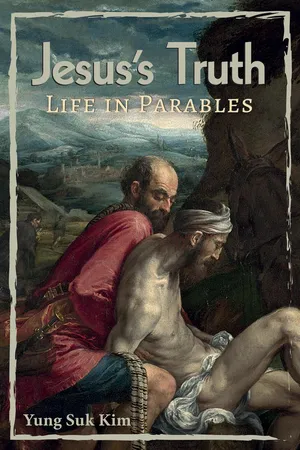
This is a test
- 124 pages
- English
- ePUB (mobile friendly)
- Available on iOS & Android
eBook - ePub
Book details
Book preview
Table of contents
Citations
About This Book
Parables of Jesus are stories about everyday life, ranging from a person's worldview to economic justice in society. This book examines most parables of Jesus from a critical literary perspective. Twenty-three narrative parables in the Synoptic Gospels are rearranged by their source: Markan parables, Q parables, Matthean unique parables, Lukan unique parables. Each parable invites readers to reengage Jesus's stories in the contemporary world.
Frequently asked questions
At the moment all of our mobile-responsive ePub books are available to download via the app. Most of our PDFs are also available to download and we're working on making the final remaining ones downloadable now. Learn more here.
Both plans give you full access to the library and all of Perlego’s features. The only differences are the price and subscription period: With the annual plan you’ll save around 30% compared to 12 months on the monthly plan.
We are an online textbook subscription service, where you can get access to an entire online library for less than the price of a single book per month. With over 1 million books across 1000+ topics, we’ve got you covered! Learn more here.
Look out for the read-aloud symbol on your next book to see if you can listen to it. The read-aloud tool reads text aloud for you, highlighting the text as it is being read. You can pause it, speed it up and slow it down. Learn more here.
Yes, you can access Jesus's Truth by Yung Suk Kim in PDF and/or ePUB format, as well as other popular books in Theology & Religion & Biblical Studies. We have over one million books available in our catalogue for you to explore.
Information
Topic
Theology & ReligionSubtopic
Biblical Studies1
Introduction
Allegorical interpretation deprives us of the true meaning of a parable by spiritualizing it. Allegory, derived from allegorein (meaning “to speak differently”), is a way of reading the text by focusing not on the internal story but the hidden spiritual meaning. In doing so, what readers do typically is to make a one-to-one correspondence between story and particular outside the story. This allegorical interpretation has been popular with the Alexandrian School (Clement, Origen, and Augustine). In the parable of Samaritan (Luke 10:25-37), the allegorical matchings go like this: Jerusalem as Paradise; Jericho as world; a robbed person as Adam; robbers as evil; priest as the law; Levite as prophets; the good Samaritan as Jesus; injury as disobedience; donkey as Jesus’s body; inn as church; the innkeeper as bishop of the church; and the promise of return as the second coming of Jesus. We can hardly think that Jesus applied himself to a Samaritan as in allegorical interpretation. Rather, we can read this parable as a story and wonder why first two religious leaders pass by without helping the needy person. They also have to think about the third person, who is not an ordinary Jewish person but a despised foreigner who need not respond to the needy person from the perspective of Jews. He could pass by without looking at this man robbed, but he stopped by and did everything he could to help him. Hearers must grapple to understand the act of this man from Samaria, a district of contempt by Jews. Who is this guy? He was not considered a neighbor by Jews. But he became a neighbor to them. This mysterious act and presence of the Samaritan raise a metaphorical imagination to hearers.1 How can a Samaritan become a neighbor? From a traditional perspective of Jews, the neighbor is found among themselves. But the Samaritan became a neighbor to a person in need.
Another famous parable of Jesus, “the father and two sons” (Luke 15:11-34), also has been read allegorically. Namely, the older son/brother represents Jews, the younger son/brother represents newly converted Gentile sinners, and the father represents the compassionate God. So much so, the older brother/son is blamed for his narrow mindset, and his father welcomes the younger brother/son because of his repentance. But inside the parable, there is no such clue that this story is understood with such “representative” interpretation. Rather, this story is taken from e...
Table of contents
- Title Page
- Acknowledgements
- Chapter 1: Introduction
- Chapter 2: Markan Parables
- Chapter 3: Q Parables in Matthew and Luke
- Chapter 4: Matthean Unique Parables
- Chapter 5: Lukan Unique Parables (I)
- Chapter 6: Lukan Unique Parables (II)
- Bibliography